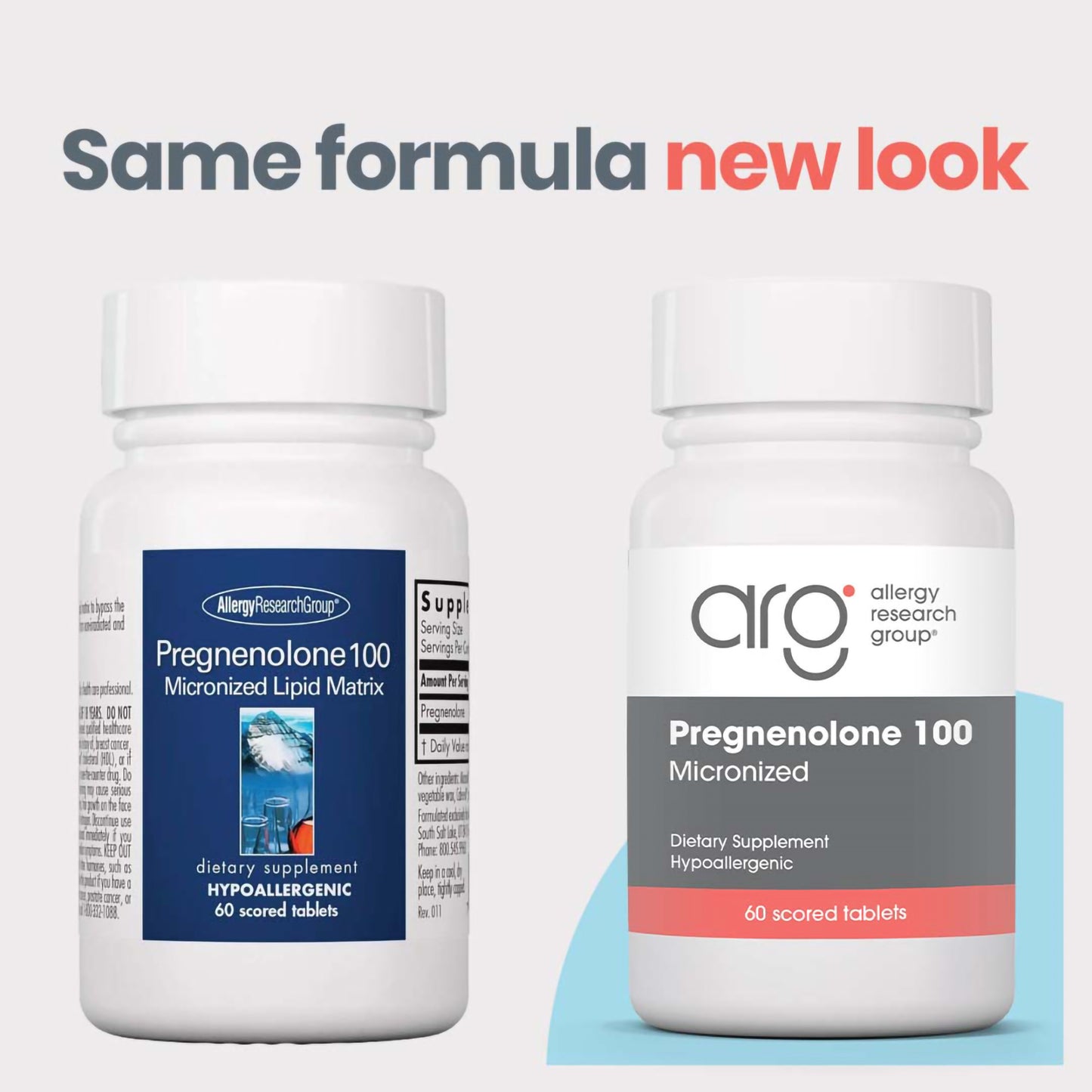













SKU:74820
Pregnenolone 100 mg
Pregnenolone 100 mg
Micronized
Product Description
Pregnenolone 100 mg is a micronized. bioavailable form of this neurosteroid and hormone precursor to support mood, stress resilience, and the synthesis of key hormones like cortisol, progesterone, and estrogen.*
Couldn't load pickup availability







-
Ingredients -
Product Information -
Suggested Use
Ingredients:
Serving Size: 1 scored tablet
Servings Per Container: 60
Amount per serving:
Pregnenolone: 100 mg
Other Ingredients:
Micosolle®, microcrystalline cellulose, vegetable oil, vegetable wax, Cab-o-sil®, magnesium stearate, vitamin E.
Micronized pregnenolone to support cognitive function, mood, stress resilience, and healthy hormone synthesis.*
What It Does
Pregnenolone is a neurosteroid and hormone precursor that plays a vital role in the production of cortisol, progesterone, estrogen, testosterone, and other steroid hormones.* It may support mood, focus, and the body’s adaptive response to stress as levels decline with age.*
How It Works
• Pregnenolone (Micronized): A bioavailable form of the parent steroid hormone that supports adrenal, reproductive, and neurological function.*[1]
• Neurosteroid Activity: Synthesized in the brain and peripheral nervous system, pregnenolone modulates GABA and NMDA receptors and influences neuroplasticity via BDNF.*[2,3,4,5]
• Hormone Precursor: Serves as the first step in the synthesis of key hormones including cortisol and sex hormones, influencing metabolism, immune balance, and reproductive health.*[1,6]
• Cognitive and Mood Support: Clinical trials suggest pregnenolone supplementation supports focus, working memory, and mood, particularly in populations under cognitive or emotional strain.*[7,8,9]
• Age-Related Optimization: Endogenous pregnenolone production decreases with age. Pregnenolone supports mental stamina and resilience.*[6,10]
• Clinical Dosing Evidence: Human studies have used 30–500 mg daily to support quality of life, attention, and cognitive performance in certain populations.*[7,8,9]
Who It’s For
Ideal for adults seeking support for healthy mood, cognitive function, or hormonal balance, especially during periods of stress.*
Special Features
ARG offers Pregnenolone (micronized) for enhanced bioavailability in 50 mg and 100 mg strength options to accommodate individualized, evidence-informed protocols.*
Pregnenolone helps bridge the gap between hormone synthesis and brain health, supporting multiple systems through a foundational neurosteroid pathway.*
References
1. Murugan S, et al. J Biol Chem. 2019;294(12):4596–607.
2. Mathis C, et al. Psychopharmacology (Berl). 1994;116(2):201–6.
3. Mathis C, et al. Neuropharmacology. 1996;35(8):1057–64.
4. Pierce SR, et al. Mol Pharmacol. 2022;101(2):68–77.
5. Charalampopoulos I, et al. Ann N Y Acad Sci. 2006;1088:139–52.
6. Vallee M, et al. Brain Res Brain Res Rev. 2001;37(1–3):301–12.
7. Naylor JC, et al. JAMA Netw Open. 2020;3(3):e200287. doi:10.1001/jamanetworkopen.2020.0287
8. Kreinin A, et al. Clin Schizophr Relat Psychoses. 2017;10(4):201–10.
9. Ritsner MS, et al. J Clin Psychiatry. 2010;71(10):1351–62.
10. Naert G, et al. Psychoneuroendocrinology. 2007;32(8–10):1062–78.
Suggested use:
As a dietary supplement, take 1 tablet daily with a meal, or as directed by a healthcare practitioner.
Warning:
NOT FOR USE BY INDIVIDUALS UNDER THE AGE OF 18 YEARS. DO NOT USE IF PREGNANT OR NURSING.
Consult a physician or licensed qualified health care professional before using this product if you have, or have a family history of, prostate cancer, prostate enlargement, heart disease, low "good" cholesterol (HDL), or if you are using any other dietary supplement, prescription drug, or over-the-counter drug. Do not exceed recommended serving. Exceeding recommended serving may cause serious adverse health effects. Possible side effects include acne, hair loss, hair growth on the face (in women), aggressiveness, irritability, and increased levels of estrogen. Discontinue use and call a physician or licensed qualified health care professional immediately if you experience rapid heartbeat, dizziness, blurred vision, or other similar symptoms.
Store in a cool, dry place, tightly capped, away from light. Keep out of the reach of children. Use only if safety seal is intact. Variations in product color may occur.
Stay Connected
Sign up and we’ll keep you up to date on the latest news, clinical education resources, product innovations and promotions.
